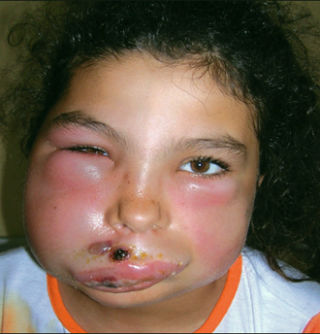
Bacillus Anthracis symptomsDescription Anthrax
Anthrax usually occurs in animals such as pigs, cows, horses and goats, but can also infect humans. Infection of humans can occur by contact of spores with a cut or scratch the skin (cutaneous anthrax), by inhalation of spores (anthrax) or ingestion of meat containing the spores (intestinal anthrax). In biological warfare, anthrax can be spread deliberately in the air or through an object that carries the bacteria. Anthrax is not spread from one person to another (it is not contagious). Symptoms of cutaneous anthrax appear almost immediately, within one day after infection. The symptoms of anthrax appear 2-6 days after infection but may not be visible until 6 weeks or more. Symptoms of intestinal anthrax appear between 1-7 days after infection. The last known case of anthrax in Canada dates from 2001, it was a case of cutaneous anthrax. CausesThe cases of anthrax resulting from natural causes are very rare in humans. By cons, anthrax can be produced in the laboratory and used as a pathogen in biological weapons. Anthrax is used for this purpose because of serious health problems that occur when the spores are inhaled. Inhaled anthrax is often fatal if not treated early stage, so it is very important to recognize the symptoms of this infection (see "Symptoms and Complications"). The most common form of anthrax is cutaneous anthrax (the skin). This form of the disease accounts for more than 95% of infections with anthrax due to natural causes. Cutaneous anthrax can occur when a person handling animals or animal products (wool or other woven materials) that are contaminated with coal, or when in contact with materials that have been intentionally infected. In North America, it is very rare that the meat is contaminated with the bacterium that causes anthrax. Therefore, intestinal anthrax is rare. Symptoms and Complications
Inhaled anthrax is by far the most dangerous form of infection, but also the rarest. The first symptoms resemble the flu and include fever, sore chest, malaise, fatigue and dry cough. The first signs of the disease can occur within 48 hours after inhalation of spores of the bacteria. If the symptoms are not treated promptly, the infection can worsen quickly and become a disease like pneumonia (lung inflammation). The symptoms are then shortness of breath, high fever, elevated heart rate and sweating. Meningitis (inflammation of brain tissue) and a pain in the abdomen follow few patients survive more than a few days after the onset of these symptoms. Fortunately, early treatment reduces the risk of mortality. Cutaneous anthrax is much less dangerous than anthrax. When infection occurs in this form, a bump that resembles an insect bite or spider, which sometimes causes itching, appears on the skin. After 1 or 2 days of wounds, the center turns black, grow. Generally, the person with cutaneous anthrax feel only mildly ill. Early treatment with antibiotics almost always successful in curing this form of the disease. By cons, if cutaneous anthrax is not treated, bacteria can enter the bloodstream and cause more severe symptoms. Signs of spreading infection include fever, chills and swollen lymph nodes near the area of ??the wound. As for intestinal anthrax, the symptoms are: severe abdominal pain, nausea, vomiting, diarrhea and bleeding from the gastrointestinal tract (stomach and intestines). It is important to remember that anthrax is not spread from one person to another. It is very rare for a person to anthrax unless the spores do not be introduced under the skin or the lining of the stomach or intestines. In addition, anthrax does not contract until after thousands of spores are inhaled into the lungs. Treatment and PreventionThe prevention of anthrax includes immunization and antibiotic treatment of people exposed to anthrax. Pre-exposure immunization is not recommended. Although still experimental, the vaccine subcutaneously (under the skin) is usually given as soon as exposure is detected, then 2 weeks later and again 2. Treatment with antibiotics is continued for at least 4 weeks (until all vaccines have been administered) and generally up to 60 days. Cutaneous anthrax in adults and children can be treated with ciprofloxacin *, doxycycline or amoxicillin for 60 days. In young children, ciprofloxacin can cause bone development problems and doxycycline can slow bone growth and cause tooth discoloration. The risks associated with the use of antibiotics for children and adolescents under 18 years must be weighed against the benefits of treatment against anthrax. The treatment of inhalation anthrax is usually to inject ciprofloxacin or doxycycline intravenously, in combination with two antibiotics intravenously (clindamycin and rifampicin). If the patient is able to swallow, these antibiotics are then taken orally for a total of 60 days. Pregnant women receive the same treatment. The Office of the Food and Drug Administration of USA (FDA) states that "there is no credible scientific evidence to indicate that dietary supplements for sale on the market allow to prevent or treat anthrax." This is in response to claims that substances such as oregano oil or mineral water with high levels of zinc can control the disease.
|
|
© 2014 "bacillusanthracis.org". All Rights Reserved |
 Anthrax is an infection caused by the bacterium Bacillus anthracis. The bacteria form spores or latent versions, protected by a hard shell. The spores form in which the bacteria causing the infection, can survive in soil for many years.
Anthrax is an infection caused by the bacterium Bacillus anthracis. The bacteria form spores or latent versions, protected by a hard shell. The spores form in which the bacteria causing the infection, can survive in soil for many years.
